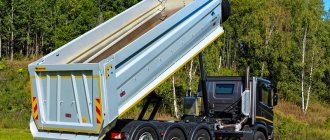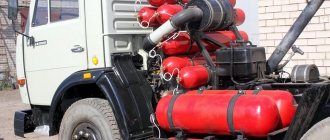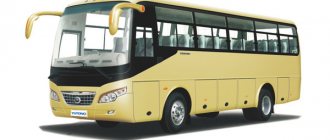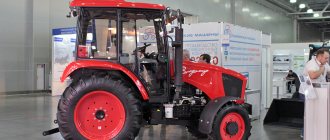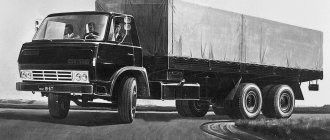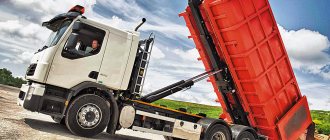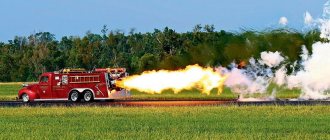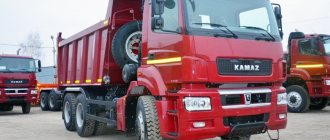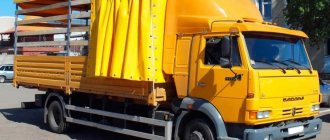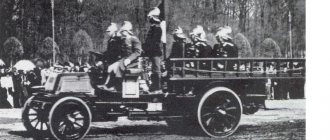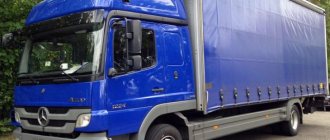Trunk silence
In front of me are 4x2 and 6x4 mainline tractors, a garbage truck, and a hook loader.
First of all, I climb into the R410 tractor with a 13-liter engine. I start the engine and am amazed at the silence: no vibrations, no background noise so characteristic of diesel engines. The gas engine is incredibly quiet, and the situation does not change when driving - only the slight howl of the wind in the mirrors and the rustling of the tires.
In addition to gas engines, Scania showed another new product for Russia - the G410 dump truck with an 8x4/4 wheel arrangement - with a rear bogie on three axles.
In addition to gas engines, Scania showed another new product for Russia - the G410 dump truck with an 8x4/4 wheel arrangement - with a rear bogie on three axles.
The traction is good: the tractor calmly pulls a large semi-trailer up a six percent climb. The engine really drives no worse than a diesel engine.
You won’t get agility from the 9-liter OC9 “five”, and this is not necessary. They put it on easier equipment. I chose the most colorful one - a bright blue P340 garbage truck. This is almost the only Scania that did not have a retarder. Therefore, on the descents of the Dmitrovsky Automotive Test Site, we had to carefully work on the brakes so as not to burn them to hell. However, the “garbage” habitat is a city where a retarder is unlikely to be useful.
Operating the retarder couldn't be easier. The intensity of deceleration is regulated by a steering column switch, and the speed on a descent is controlled by a switch on the steering wheel hub.
Operating the retarder couldn't be easier. The intensity of deceleration is regulated by a steering column switch, and the speed on a descent is controlled by a switch on the steering wheel hub.
Scania P340: the first to run on methane
Text: Scania
Photo:
– Oleg, tell us how your project began?
– My partner Andrey Petrov and I are both transport workers, we have been involved in logistics for a long time, we have already implemented several projects. The idea to create a motor transport company appeared about three years ago. It is based on saving on fuel. In the current economic conditions, starting a small business in the transport sector is impossible without some kind of innovative “zest”. We studied all possible options: LNG (liquefied natural gas), even electricity (there are battery-powered tractors), but in Russia the time has not yet come for it. But methane is already a thing today. Especially for Russia. Just look at the Chinese experience.
We asked ourselves the question: why is natural gas used by buses, other urban transport, and private owners in passenger cars, but not in long-distance transportation, where the most fuel is consumed? Although the savings effect is more significant. The main obstacles: lack of appropriate equipment on the market, insufficient CNG filling station infrastructure, risks facing the “untested”. The technology has appeared, the problem of gas stations is gradually being solved, but we are no strangers to taking risks. In general, everyone did the math, built a development program, and dived into the unknown.
– How did you choose the equipment for long-distance transportation?
– We started with two Chinese methane tractors, since at that time only this model was certified in Russia. Then two European cars appeared, and one of them was the Scania P340. We immediately bought the first Scania test tractor on methane, and our project got a start in life thanks to a worthy car. Then we bought another batch and another - now we have 12 of these vehicles in our fleet, and they run perfectly with semi-trailers between two capitals, and sometimes even to the Urals or Krasnodar. To increase the mileage between refuelings, we installed additional gas equipment on them, which increased the mileage from 500 km to 800-900 km for a loaded truck. By the way, we must thank Gazprom Gas Engine Fuel, namely the North-Western Branch: under its programs we received compensation for the costs of installing cylinders.
– How profitable is it to use methane-powered tractors?
– We get double savings, and the calculation here is very simple. A loaded diesel truck consumes an average of 35 liters. per 100 km. Let’s take, for example, the round trip from St. Petersburg to Moscow – it’s 1,500 km. That is, with a diesel cost of 40 rubles. per liter you will need a little more than 20 thousand rubles.
The average consumption of a loaded 20-ton methane truck is 42 nm3 per 100 km. The cost of methane in the North-West region is 16 rubles/nm3. Accordingly, fuel costs for the same round trip are approximately 10 thousand rubles.
Given the market cost of such round-trip transportation is 60-70 thousand rubles, a saving of 10 thousand is quite noticeable. Only through this, in my opinion, is it possible for us to “beat” the high cost of money in our market and replenish our fleet with new, and not the cheapest, equipment.
– Why did you decide to open your own gas station?
–
I have already spoken about insufficient infrastructure. Let's take, for example, the route between the northwestern and Moscow regions along which our cars ply. There are only two gas stations - on Pulkovskoye Highway, in the city of Tosno, Leningrad Region, and the next one is only in Tver. The construction of a fuel filling station in the middle of the M10 highway was the second part of our business project. In two years, we did everything necessary: we found a place in the city of Valdai, 50 meters from the highway, resolved issues with land management, received technical specifications, installed a gas pipeline, electricity and installed a CNG filling station. Started working in June 2022. Now our cars can be refueled with CNG midway. Our colleagues who have methane-powered equipment also refuel there. To do this, you need to conclude an agreement with our CNG filling station, or purchase a Gazprom - GMT card.
– Are you going to expand the CNG filling station network?
– We do not plan to expand the network of gas stations; we will continue to develop in long-distance transportation. The first stage of development has now been completed, which consisted of creating a basic (to meet demand at our own CNG filling station) automobile enterprise with a fleet of 10-12 cars, organizing its operation, solving marketing problems, acquiring customers, and also building a CNG filling station, as we need an infrastructure facility for the stable functioning of a business. In the next two years, we intend to expand our fleet to 30-50 vehicles, and we are leaning towards Scania because we are satisfied with the quality of the cars. Now the mileage of our very first Scania P340 is already 400 thousand km. The mileage of the second batch of cars exceeded 200 thousand km.
It is known that in May of this year, Scania presented in Russia a new generation tractor powered by natural gas with a new engine with a capacity of 410 hp. In our future plans, we have high hopes for this particular car.
– On what terms do you purchase cars?
– We immediately chose the “Scania Drive” package offer, and we are working on it. It's convenient: leasing purchase, including driver training service, FMS satellite tracking system and Scania Flex service contract, which is prescribed for the entire leasing period of 5 years.
– What do you think can contribute to the growth in the use of methane-fuelled mainline equipment in Russia?
– Russia is one of the main suppliers of natural gas in the world and, as far as I know, the authorities are making efforts to develop the domestic sales market. The gas station infrastructure will be improved, and LNG gas stations may also appear. In general, the share of methane technology in long-haul transportation will definitely grow rapidly. Because it is not only profitable, but also environmentally friendly, which is also very important.
While development is also hampered by the inertia of thinking of carriers, fears of a new type of equipment, the cost of which, for example, in five years on the secondary market is unknown, because it is still very young. Therefore, there is an unknown quantity in their economic calculation. This is understandable - it takes time and experience in using the technology. According to our estimates, based on communication with specialists, the wear of a gas engine will be even less than that of a diesel engine, that is, in terms of service life, a methane-powered tractor can only exceed a diesel one. In general, time will tell. Meanwhile, our experience already confirms that we are on the right path.
Administrative barriers and infrastructure
The Scania CNG G340 LA 4×2 MNA truck tractors, which have become the subject of my close attention, are manufactured just like gas ones at a plant in Sweden and certified in the Russian Federation; owners do not have to go through bureaucratic thresholds to formalize changes to the design of the vehicle. This is definitely a plus. But you will still have to fork out for a set of administrative measures such as certification and verification of equipment.
The next problem is infrastructure. For example, in Moscow and the region there are 8 CNG filling stations, the majority are located in the east and southeast, which means there is a problem of overrunning empty vehicles. Another thing that limits the use of compressed gas in internal combustion engines is the altitude above sea level. Efficiency drops significantly at around 1500 m, but for the vast East European (read Russian) plain this is not scary...
Main characteristics of gas-cylinder KAMAZ
The motor is here, represented by model 820.60. Vehicle parameters: 7300X2500X2845 mm. The model is equipped with an interaxle differential lock and inter-wheel lock, and has spring lighting installed.
Consumption of this KAMAZ model on methane: 34 l./100 km. (same as 65205) Model price 2,857,220 rub.
We also recommend that you familiarize yourself with the technical characteristics of KamAZ 43118.
All information about Kamaz can be found on our website. This is an overview of the dimensions of Kamaz equipment.
You will learn about the capacity of Kamaz in this article..
It will also be interesting to see the price range for Kamaz.
City Bus 5299-30 on methane gas - characteristics and fuel consumption
Bus 5299-30
Transportation of citizens and guests of the country along narrow city roads is now possible using gas-cylinder semi-low-floor transport.
All-metal body, double doors with pneumatic drive. Rear engine. Ventilation is classic, through opening hatches and molds. 984 l. constitutes the total volume of the fuel system cylinders, it can accommodate 197 m3 of CNG at a force of 200 atm. The semi-low-floor design increases the convenience of getting into and out of the vehicle.
The power unit uses a VOITH D845.3E gearbox. The KAMAZ gas engine is represented by model 820.61. Characteristics of the 5299-30 KAMAZ methane model. Overall dimensions: 11875Х 2050Х 3400 mm. Model price 7,660,000 rub.
For transporting citizens and guests of the country along routes that lead outside the city, class 2 transport 5299-0000011-31, model 5299-011, is suitable. It has seating available, as well as areas that are most suitable for passengers who want to stand.
The bus consists of an all-metal frame, one-piece body. The advantage is its resistance to maintaining the desired air temperature and the rear location of the engine. Ventilation is natural, through open windows and hatches.
Heating system: built-in autonomous and emergency. The first one works from a gas heater, the other one works in addition to the main one. These are the main features of this Kamaz model on methane. Model price 8,708,300 rub.
